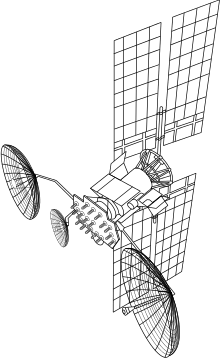KAUR (satellite bus)
The KAUR (Russian: КАУР, Космический Аппарат Унифицированного Ряда, Universal Spacecraft Series) was a very successful satellite bus designed and manufactured by ISS Reshetnev (then NPO PM). It is a pressurized bus originally developed in the 1960s, it has been used from low Earth Orbit to medium Earth orbit and even to GEO. It has four different generations and its different versions have been used from civilian communications to satellite navigation.

Generations
KAUR-1
The KAUR-1 was a pressurised cylinder with a diameter of 2 m, length of 3 m and weighed 800 kg. It had no propulsion system, and instead used a passive single-axis magneto-gravity stabilisation system.[1] First generation of the bus, used on:
KAUR-2
The KAUR-2 was designed by OKB-1 (and later Reshetnev Company) for the Molniya satellites. It was originally an experimental bus, but after successful missions, was put into production.[2] The bus had a sealed 2.5 cubic meter internal volume to stabilize the temperature. Its attitude control system could point with a 10° accuracy, and transmitted in the 10 m bands. Its propulsion system was derived from the Venera 1VA probes. It used the KDU-414 propellant system and S5.31 engine from 1960 to 1974, after which it upgraded to the KDU-414A with the S5.114 engine. This had a specific impulse of 290 seconds.[3]
KAUR-3
This was developed in the 1960s for the first Russian geosynchronous communications satellites, for repeaters and TV broadcasts. It has a three-axis attitude control system with an accuracy of 0.25°, and independently tracking solar panels.[4]·[5] As part of the development, in July 1974 a Proton DM rocket put a Molniya-1 into geosynchronous orbit as a test communications methods.[6]
KAUR-4
The KAUR-4 was designed for Russian geosynchronous satellites in the 1980s. It reached flight status in the 1990s.[7]
Ekspress
While not presented as such, the Ekspress satellite bus can be considered at least its replacement. It is an unpressurized bus originally designed for GEO, but that has been adapted for medium Earth orbit and to highly elliptical orbit.[8]
See also
- ISS Reshetnev – Designer and manufacturer of the platform.
- Ekspress (satellite bus) – The platform that replaced KAUR for the most demanding applications.
References
- Brian Harvey; Olga Zakutnyaya (2011). "Russian Space Probes: Scientific Discoveries and Future Missions". Springer Science & Business Media. ISBN 1441981500.
- "KAUR-2". Astronautix.
- Gunter Dirk Krebs. "Molniya-1". Gunter's Space Page.
- "Raduga". Russian Space Web.
- Gunter Dirk Krebs. "Raduga (Gran, 11F638)". Gunter's Space Page.
- "KAUR-3". Astronautix.
- "KAUR-4". Astronautix.
- Anatoly Zak. "Ekspress 1000N". Russian Space Web.